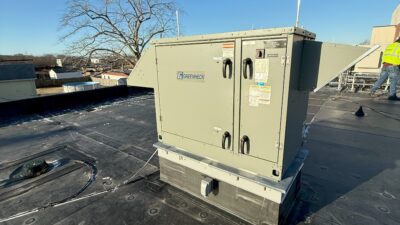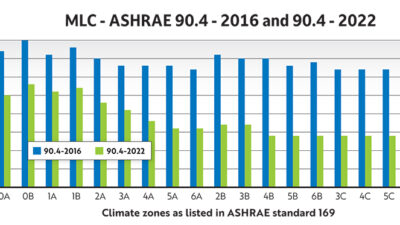February Deep Links: Some significant confusion has crept into the industry that now leaves the electrical inspector wondering if the installation he is reviewing really does meet the requirements of the NEC. The discussion that follows attempts to present the issues and offer some suggestions.
Abstract: The Y2K issue prompted wide spread application of standby power to important loads. This promulgated small-scale on-site generation. Many of these installations were for residences and small businesses. Given that cost is an important consideration at this scale, it was felt that other interpretations of UL Standards and the National Electrical Code (NEC) could be used since such systems were only optional standby applications. As a result, some significant confusion crept into the industry that now leaves the electrical inspector wondering if the installation he is reviewing really does meet the requirements of the NEC. The discussion that follows attempts to present the issues and offer some suggestions. It remains for the standards-writing and code-enforcement agencies to resolve the issues.
Introduction: The National Fire Protection Agency, (NFPA) is the author and custodian of the National Electric Code, NFPA 70. In most political jurisdictions, this code is the governing document against which electrical installations are judged for their potential hazards and lack thereof. This code is sometimes augmented with local requirements to meet the unique needs of a given political jurisdiction. Whatever the case, electrical construction is governed by code requirements.
The code requires all electrical equipment to be suitable for its intended use in any given application. Given the infinite permutations of electrical equipment configurations, it is unrealistic to expect that any individual could be sufficiently knowledgeable to assess the suitability of a piece of electrical equipment for any given application. The code recognizes this. The assurance of suitability comes from the independent evaluation of electrical equipment with respect to acceptable standards. The code acknowledges the suitability of electrical equipment when it is listed by an independent testing laboratory regularly engaged in such efforts. It states that the agency having jurisdiction or the electrical inspector may accept such listing and/or labeling as evidence of suitability.
This is where the confusion surfaces. The requirement is for equipment suitable for its intended service in the specific application. The label does not always indicate the service for which the product is suitable and intended for. In some cases, even the standards promulgate confusion. When this occurs, the need for clarification exists. Such is the case with standby power. Y2K and the increased use of hi-tech office equipment have created a sizable market for optional standby equipment.
Manufacturers have responded to this opportunity by trying to fit existing products into the market opportunity. As a result, manufacturers have petitioned the standards-writing agencies to modify some of the standards to allow use of their product. When unassociated groups prepare different standards, it is likely that contradicting standards will be issued. It is believed that this is the case with respect to the qualification of transfer equipment. UL 1008, “Standard for Safety Transfer Switch Equipment” establishes the minimum qualification requirements for transfer-switching equipment. A conflict has arisen in UL 67, “Standard for Safety Panelboards,” Section 25A “Transfer Equipment Panelboard Tests” and UL 98, “Standard for Safety Enclosed and Dead-Front Switches,” Section 20, Par. 20.5. The change to UL 67 becomes effective February 9, 2001. Because it is new, and likely an oversight by UL, when the issue is resolved, the indications are that transfer-switching equipment will be required to be qualified to UL 1008.
Codes and standards
There are a few codes used throughout the world. The most common are:
CEI IEC: International Electrotechnical Commission
CSA: Canadian Standards Association
NFPA: National Fire Protection Agency
For countries having membership in the European Economic Community, IEC standards are in force. IEC 60364-5-51 “Electrical Installations of Buildings,” Part 5: “Selection and Erection of Electrical Equipment,” Chapter 51: “Common Rules,” Article 511: “Compliance With Standards,” Par. 511.1 states, “Every item of equipment shall comply with such IEC standards as are appropriate..” NFPA 70 National Electric Code, Chapter 1 General, Article 110 “Requirements for Electrical Installations,” Paragraph 110-2 Approval, states, “The conductors and equipment required or permitted by this Code shall be acceptable only if approved.” Paragraph 110-3 “Examination, Identification, Installation and Use of Equipment,” states, “In judging equipment, considerations such as the following shall be evaluated:
(1) Suitability for installation and use in conformity with the provisions of this Code…” Par. 110-3.b Installation and use states, “Listed or labeled equipment shall be installed and used in accordance with any instruction included in the listing or labeling.” Article 700-3 “Emergency Systems” states, “All equipment shall be approved for use on emergency systems. Article 701-4 “Legally Required Standby Systems” states, “All equipment shall be approved for the intended use.” Article 702-4 “Optional Standby Systems” states, “All equipment shall be approved for the intended use.” Article 90-7 “Examination of equipment for Safety” states that “equipment evaluation made under standard conditions will provide a basis for approval.”
It is accepted that Underwriters Laboratories is a qualified testing agency. Further, it is recognized that products bearing the UL label can be considered as approved. This is where the confusion begins. The only standard for safety for transfer-switch equipment in the United States is UL 1008. In Canada, it is CSA 22.2-178. In countries governed by IEC standards, the applicable standard is IEC 60947-6-1.
Certain manufacturers argue that UL 67, “Standard for Safety for Panelboards” and UL 98 “Standard for Safety for Enclosed and Dead Front Switches,” also apply. The view taken in this discussion is that these standards do not provide an adequate basis for qualification of transfer-switch Equipment to the needs of safety.
It is concluded that Underwriters Laboratories does not intend to issue two or more standards for any given product that are in conflict with each other. Evidence of this can be found in UL 2200 “Standard for Safety for Stationary Engine Generator Assemblies.” Section 10.8 states, “A transfer switch used to connect the load shall comply with the applicable requirements in the “Standard for Automatic Transfer Switches,” UL 1008. If the alternate supply consists of a stationary engine generator set, the only transfer-switch equipment permitted is that which is qualified to UL 1008.
Evaluation
Why is this an issue? Why does a switch approved to UL 67 or 98 not satisfy the qualification criteria for use as transfer-switch equipment? What is needed for transfer switch service? The uniqueness of transfer-switch equipment is that it transfers a selected load between two independent power sources. These power sources are not in synchronism. At any given time, the voltage across the open main contacts can be twice the operating voltage of the system. One could argue that the test defined in Section 25.A of UL 67 addresses this issue. This sequence requires switching between sources of opposite polarity. The fact is that the test described in 25A of UL 67 is a no load test. Anyone who has manufactured transfer-switch equipment will readily acknowledge that switching under no load conditions is not a problem. The difficulty arises in switching between two live sources—for example, retransfer of the load to the utility source upon its restoration&$151;when current is flowing to the load. To account for this, UL 1008, “Standard for Safety for Transfer Switch Equipment,” requires that this transfer and retransfer be conducted for overload and endurance regimens. This standard does allow for different transfer-switch applications.
For the case of the residential users, so called Art. 702 users, the required applicable rating would be for total system load. This category includes provision for motor load content. Any optional standby power application will of necessity be required to transfer mixed loads. Motors for sump and well pumps, refrigerators and freezers, heating and ventilation will be a part of the optional standby load profile. Therefore, the transfer-switch equipment needs to be capable of transferring motors. The total system load category of UL 1008 meets the needs of the residential load. For this category, the overload and endurance tests are conducted at power factors and currents beyond those required by UL 98. UL 67 does not cover any load switching device at all. It is the safety standard for qualification of a panelboard. Thus it pertains to the enclosure, bus and mounting provisions for devices intended to be mounted in a panelboard. The products to be mounted in the panelboard will be qualified to UL 98 or UL 489 “Standard for Molded-Case Circuit Breakers and Circuit Breaker Enclosures.”
UL 67, Sec. 25A.1 and UL 98 Sec. 20.5 make a reference to ART. 702 of the National Electric Code, ANSI/NFPA 70. From this, one would think a device that meets the requirements of these standards is suitable for use as Transfer Switch Equipment. I would suggest that these new additions to these standards were made without any investigation or notification of standards committees normally involved in drafting standards for the qualification of transfer switching equipment. The present standard for transfer-switching equipment, UL 1008 covers all transfer-switching applications. This is borne out in UL 1008, Sec. 1, Par 1.1 a) which reads: “a) Automatic transfer switches and by-pass/isolation switches for use in emergency systems in accordance with Article 517- Health Care Facilities, 700-Emergency Systems, 701-Legally Required Standby Systems and 702_optional Standby Systems of the National Electric Code, ANSI/NFPA 70.”
Para. 1.6 reads in part, “operated manually by a physical action, or electrically by a remote control.” From this inclusion, it is clear that transfer switching equipment of all types is covered by UL 1008. When qualified to UL 1008, transfer-switch equipment is suitable for transfer-switch service. A full qualification regimen is conducted when transfer-switch equipment is examined against UL 1008. This regimen includes:
Operational performance.
Overload switching at 6 X rated current and 0.5 pf.
Temperature rise.
Endurance switching, half at 2 X rating and the remainder at 1 X rating for electrical performance. After this, a regimen of no load switching is conducted.
Dielectric voltage-withstand.
Fault current withstand and close on tests.
Neither UL 67 nor 98 require a qualification regimen that would assess the suitability of a device for transfer-switch service. UL 67 does not address the electrical ability of devices to be mounted in the panel board. To evaluate the product properly for any particular item, the inspector would have to know which device was to be used to comprise a transfer scheme and then go the relevant standard to see what that device was rated to do. Additionally, an investigation into the switching device listing would have to be conducted to determine if it was suitable for SWD service. Where a circuit breaker is to be used in switching service, UL 489 provides a test regimen to confirm suitability. That does not include suitability as transfer-switch equipment.
UL 1008 does not preclude the use of double throw manually operated safety switches or interlocked circuit breakers from being integrated into transfer-switch equipment. It does, however, require qualification of the assembly to the transfer-switch qualification regimen. Similarly, IEC 60947-6-1 is the standard for automatic transfer-switching equipment in the European Union. This standard and UL 1008 are virtually the same. The IEC standard also allows the use of devices not originally designed for transfer-switch service. However, as is the case with UL, this standard requires that components designed, qualified and certified to other standards be subjected to the test regimen for ATSE. The only exclusion is where the qualifying test regimen for these devices is more severe than that for ATSE. Even though IEC standards closely aligned with UL standards for similar devices exists for circuit breakers (IEC 60947-2), switches (IEC 60947-3) and contactors (IEC60947-4), IEC 60947-6-1 requires qualification of these components to the automatic transfer-switching equipment standard.
Conclusions
Transfer-switch service is demanding of those products listed and/or labeled to UL1008. The test regimen of this ATSE standard is more severe than that for circuit breakers, safety switches and contactors.
Installed electrical equipment must be approved for its intended use.
Section 25A of UL 67 and section 20.5 of UL 98 are in direct conflict with UL 1008. Letters have been written to UL to resolve this conflict. It is concluded that the references to transfer equipment in UL 67 and UL98 will be revised to require transfer-switch Equipment to be qualified to UL1008.
It is unrealistic to require an electrical inspector to be thoroughly familiar with the requirements for qualification of electrical equipment. To overcome this, the NEC provides for independent certification of products to applicable standards. Listing and/or labeling of products is proof of qualification. That a product bears a label or is listed is not sufficient evidence of suitability. The product must be qualified to the appropriate standard. The label on products qualified for transfer switch service will state so.
Only when the equipment bears a label stating suitability for transfer switch service can the inspector know that the equipment is suitable for the intended service. There are several transfer switch labels (Automatic, Non-Automatic, Bypass, etc.) However, in each case the label will state “Transfer Switch.” The inspector needs to be aware of these variations.
Written by James M. Daley, P.E., Automatic Switch Company.



